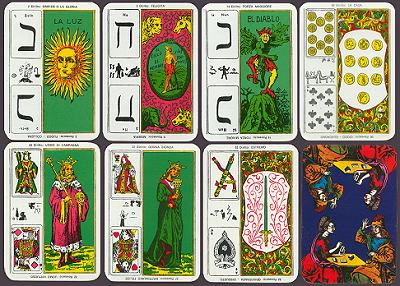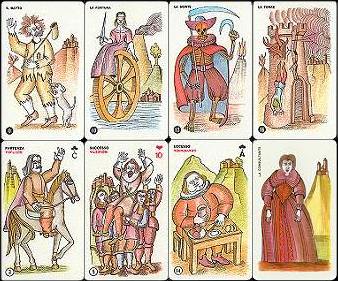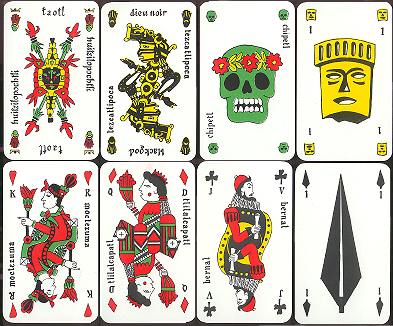The modern range of tarots includes a number of editions which do not follow the classic schemes concerning the illustrations featured on the cards, the graphic style, the deck's composition, etc., branching off from the centuries-old tradition, partly because these decks were devised for a different use (mostly cartomancy), and partly due to sheer commercial reasons, among which the fairly large number of collectors who care for these editions.
The earliest samples of cartomancy tarots appeared in the 18th century, by the time this practice began to grow popular, at first in France, then also in the rest of Europe. Despite in these decks the subjects remained basically the same as in classic tarots, both their formal and symbolic interpretation changed, on the grounds that their illustrations had conceiled for ages obscure meanings, which only the disciples of esoteric or occultist septs were able to perceive and reveal. This substantially reversed the original concept of the trumps, likely devised as an "educational" game, with the purpose of teaching the players some ethical and philosophical notions, yet expressed by means of allegories, which the cards divulged. The same trumps were arbitrarily renamed
major arcana, to underline their mysterious and secret nature. Such interpretation led to an important alteration of some subjects, as in the case of
the Trivial Performer, the first trump of the series in classic tarots, representing the lowest level of human condition, which in cartomancy decks was turned into
the Magician, whose special powers clearly allude to a much higher status than the average mortal man.
Despite nowadays the number of these editions has grown, up to the point of being manufactured in a much larger quantity of copies than classic tarots, this website does not dedicate to this topic an in-depth discussion, briefly introducing this topic and showing a few samples;
Playing Cards, as the same name suggests, onlt deals with decks originally made to be played with. Who is interested in this kind of tarots, though, should not miss the comprehensive collection reviewed at
Tarot Passages.
CARTOMANCY TAROTS
Designed by the Scottish artist Fergus Hall, the deck shown on the left, whose official title is Tarot of the Witches, became famous as "007 Tarot" after having appeared in a movie from the well-known James Bond series, Live And Let Die, 1973. They are beautifully illustrated in a rather peculiar style, dreamlike and naively disproportioned, with very intense colours obtained from original pictures painted as oil on canvas. The background of the suit cards is green for Coins (correctly named, instead of the more common yet quite gratuitous term "Pentacles"), blue for Cups, red for Swords and brown for Batons. |

Fergus Hall's Tarot, by AG Müller & Cie (Switzerland) |
A "007" motif is featured on the back, recalling the movie. It was published by the Swiss firm AG Müller for the European market, and by US Games Systems for the American one.
This so-called Egyptian Tarot is the reissue of a Spanish deck printed around year 1900 which, in turn, was based upon a French 19th century edition named Grande
Jeu de l'Oracle des Dames. It is one of the earliest cartomancy tarots with "extra" elements that accompany the main illustrations, arranged vertically in the left half of each card.

Egyptian Tarot (manufacturer not stated) |
In major arcana, a box at both ends of the card contains a different Hebrew letter for each subject; in fact, according to an esoteric interpretation, a relation exists between the 22 arcana and the letters of the Hebrew alphabet. This theory was inspired by the Kabbalah, the Jewish mystical-esoteric doctrine, which assigns a given numeric value to each letter. On these grounds, the ordering of such letters-numbers and their match with the subjects of the arcana are crucial details for the meaning that each card is said to convey.
|
The suit cards, or minor arcana, instead, feature miniature cards in place of the Hebrew letters, one with a Spanish-suited pattern (Catalan) and one with standard French suits (international).
In all the cards of the deck, the central space of the left half features some Egyptian hieroglyphs, of obscure meaning, which account for the name Egyptian Tarot.
Along the upper and lower rim of each card, its alleged divination meaning can be read.
On the back of this edition is a colour reproduction of a famous 15th century etching by Israel van Meckenem,
"The Card Players".
The tarot shown below, drawn by Sergio Ruffolo,
is manufactured by Dal Negro (Italy). Its name,
Tarocco Indovino ("clairvoyant tarot"), suggests that this edition too is a typical fortune-telling pack, i.e. not intended for playing.
Both the trumps and the suit cards feature personages related to the magic meaning that each subject is said to hold, which is stated in the upper left corner. There are also two extra subjects with no meaning, called the male Consultee and the female Consultee.
The illustrations are in a playful, almost cartoon-like style, with a prevalence of pastel colours; the graphic result is rather unusual for a tarot, but still nice.
The tiny indices are in Italian ("R" for king, "D" for queen, "C" for cavalier and "F" for
knave), while the suits are the French ones, two unusual features, since classic tarots
use Italian suits, and never have indices. |

Tarocco Indovino, top row: the Fool, Fortune, Death, the Tower;
bottom: cavalier of Clubs ('Departure'), 10 of Hearts ('Success'),
ace of Spades ('Excess') and the female Consultee |
NON-STANDARD TAROT DECKS
Among modern tarots there are also some non-conventional decks, i.e. the ones which do not comply with the standard composition (22 trumps plus four series of suited cards). The edition shown below is called Taotl, and it was manufactured in Italy, although it
is described as "Mexican tarot"; in fact, the name of the deck means "God" in Aztec
language.

Taotl deck (by Viassone, Italy): Taotl, Black God, Chipetl, ace of Totems,
King of Hearts (Moctezuma), queen of Diamonds, jack of Clubs, ace of Spades |
The cards in the pack are 72. The trump cards are only seven: three gods (Red God, Black God and
Taotl), and four identical Chipetl cards with a green skull. The remaining 65
cards are divided into five suits: Hearts, Diamonds, Clubs, Spades and ...Totems (actually,
they are masks!). Each suit has values running from 1 to 10, and three courts (jack, queen and king). Their illustrations are consistent with the theme of the deck, as the red-suited courts feature native Aztec personages, while the black
ones feature Spanish conquerors.
Two individual booklets come with the deck; one explains the rules for the Taotl game (a trick game,
somewhat reminiscent of Bridge), and the other one provides the instructions for card reading.
|
further reference to tarot decks can be found in Trionfi and in
The Hermitage
OTHER GALLERIES






















or back to

INTRODUCTION
AND HISTORY
|

MULTI-LANGUAGE
GLOSSARY |

THE FOOL &
THE JOKER |

INDEX
TABLE |

REGIONAL
GAMES |

PLAYING CARD
LINKS |